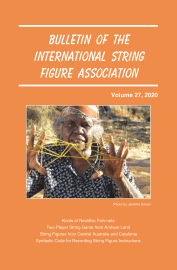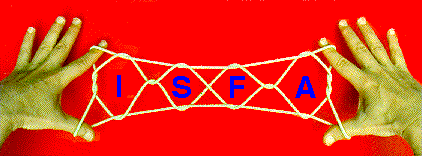Volume 27 (2020): 239 pages - Table des Matières
Edité par - Mark A. Sherman, Pasadena, California
Rédacteurs Associés - Joseph D'Antoni, Queens, New York; Myriam Namolaru, Haifa, Israel;
Belinda Holbrook, Davenport, Iowa; Stephan Claassen, Best, Netherlands.
Comité de Rédaction - Hiroshi Noguchi, Tokyo, Japan; Philip Noble, Inverness, Ecosse
Le Bulletin de l'Association Internationale du Jeu de Ficelle (BISFA) est une publication savante
présentant des documents originaux qui fait progresser notre compréhension et renforce
notre plaisir des jeux de ficelle. BISFA est publié annuellement, en septembre, par ISFA Press
(Pasadena, Californie). BISFA remplace le Bulletin de l'Association des Jeux de Ficelle,
(Toky Nippon Ayatori Kyokai), qui a été publiée en 19 volumes (1978-1993).
Les traductions proposées ne comprennent pas les illustrations et photos du texte original.
J'ai traduit ces textes pour vous donner un aperçu de la qualité et de la richesse de
ces publications.

Research Reports
The knots of neolithic fish-nets by Martin Probert, Plymouth, England (pages 1-3) - Neolithic fish-nets which have been found during excavation utilise one of three distinct ways of joining the separate cords of the mesh: the cord that is passed around the other is given either a simple knot, or a single twist, or a triple twist. The three types of join are illustrated by the linked strings in the centre of the following string figures.
A Two Player String Game from Arnhem Land, Australia by Philip D. Noble, Inverness, Scotland (pages 4-29) - This paper describes a two player "take off" string game played by two women from Arnhem Land, Australia, at the Melbourne Museum in 2005. The game was filmed by Judy McKinty. The various moves in the video are tabulated and reference is also made to the interaction between the players as they interact and share ideas of how to continue the series when the sequence appears to be breaking down. In such situations of break down, there is never a sense of criticism implied. It is also recognized that the traditional "taking off" moves demonstrated in the video, while very repetitive, can produce a wide variety of different patterns. It is suggested that this series would be capable of many more variations should a greater variety be performed.
Playing with the long strings: a structural analysis of Arandic string figures by April Pengart Campbell, Ti Tree, Australia, Stephan Claassen, Best, Netherlands, Jennifer Green, Melbourne, Australia, and Veronica Perrurle Dobson, Alice Springs, Australia (pages 30-136) - Australia is home to a rich and diverse range of Indigenous narrative practices and verbal art forms. These are highly valued and part of the 'intangible cultural heritage' of Indigenous Australians. Making string figures is one such practice, and early records from across the continent suggest that the tradition has a time span that stretches back, at least to the early days of colonization. In this paper we outline some of the sociocultural contexts of Arandic string games from central Australia, and then give a structural analysis of the figures recorded. We look at both similarities and differences in figure construction, comparing the Arandic figures to other records of string figures, both from within Australia and further afield in parts of Oceania. We then apply a formal analysis, in the string figure tradition, to our collection of Arandic string figures and highlight some figures and methods of construction that appear to be unique to central Australia.
String Games in Catalonia by Stephan Claassen, Best, Netherlands (pages 137-199) - This paper presents two different string games that are known in Catalonia, along with a description of their context. Comparative remarks accompany each game. The paper is based on previously published information on Catalan string games, information found on the internet, and field recordings made by the author in 2019. The term "string games" is used here instead of the more generally used term "string figures", because in Catalonia the focus is not so much on the actual figures that are being made as on the playful interaction between the players in the game. The Catalan string game corpus consists of one two-player take-over series and one action figure mimicking a saw, but variations do occur. Both are also found in other parts of Europe and the world, although some details are not. The use of the string with which the pastry eaten on festive days is packed is a particular custom in some parts of Catalonia. String games from Basque Country and from the area around Madrid are presented in appendices, as is an interpretation of a recording of La Scie, a saw-like string figure from France, originally published in 1860 (or 1856).
A Symbolic Code for Recording String Figure Instructions and an Intersection Diagram Drawing Method: An unpublished Japanese manuscript by Yasushi Ishida by Naoki Kato, Kanagawa, Japan (pages 200-214) - In this article, I present an English translation of an unpublished manuscript written by Yasushi Ishida. The script described his original symbolic notation and an entirely new string figures diagram. It is also discussed that he was a pioneer in the collection and study of foreign string figures in Japan. (Note: A version for readers of Japanese can be found here.)
Letters to the Editor (pages 215-223)
"The String Merels" A Two Player String Game Description from Eastern Thrace - Stephan Claassen. The author provides a partial English translation of a Greek description of the two-player cat's cradle series, written by Callisthenes Hurmuziades and published in 1940-41. Based on Hurmuziades' descriptions the first six stages are believed to be identical with those described by Jayne (1906), but the seventh stage can either be that described by Jayne or an alternative ending that produces a figure called "needles" in English translation, which the author describes how to make.
International Workshop in ACT, Australia - Philip D. Noble. The author describes a second workshop he attended in June, 2019 on string figure-making practices. It was organized by Robyn McKenzie of Australian National University in collaboration with Eric Vandendriessche, the coordinator of a four-year research project entitled “Encoding and Transmitting Knowledge with a String” (ETKnoS). The author provides a summary of each day's activities and shares his impressions.
Nomenclature - by Mark Sherman (pages 224-239)
Abbreviations and terms used throughout the Bulletin are summarized and illustrated. Step-by-step illustrations for making five string figures (Look!, Drum, Two Fawns, Face Mask, and Two Arrowheads) are provided as examples.
Ajouter un commentaire






